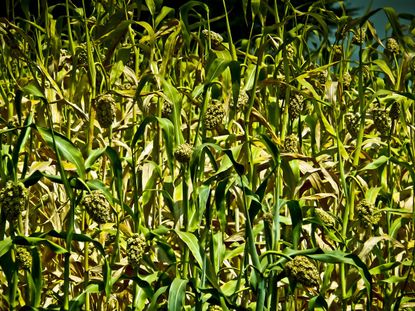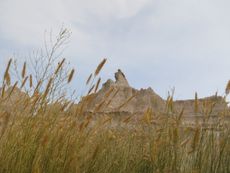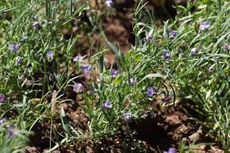Sudangrass Cover Crops: Growing Sorghum Sudangrass In Gardens


Cover crops like sorghum sudangrass are useful in the garden. They can suppress weeds, thrive in drought, and may be utilized as hay and forage. What is sudangrass, though? It is a fast-growing cover crop that has a broad root system and can grow in many areas. This makes the plant excellent at rejuvenating areas that have been overcropped and compacted or low in nutrients. Learn how to grow sudangrass and take advantage of all its many benefits along with its ease of care.
What is Sudangrass?
Sudangrass (Sorghum bicolor) may grow from 4 to 7 feet (1-2 m.) in height and is grown as pasture, green manure, hay, or silage. When it is hybridized with sorghum, the plants are slightly smaller and easier to manage with superior high heat tolerance. In addition, sorghum sudangrass care is minimal, as the seed needs little moisture to germinate, and the seedlings thrive in heat and low water regions. The biggest need for this versatile grass is at least eight to ten weeks of fine weather before harvest. Sorghum sudangrass has been shown to reduce weeds when planted thickly as well as suppress root nematodes. The plant has also been shown to be extremely efficient in water absorption with twice as many roots as corn but less leaf surface, which allows evaporation. It is also grown for its seed, as the grass is a prolific seeder, economically providing the next generation of the crop. Good soil management ensures future crops, prevents erosion, and is part of the ecological wheel of sustainability. Sudangrass cover crops are an essential part of soil management in many areas of North America and are widely used as one of the highest yielding forages too.
How to Grow Sudangrass
The best soil for sudangrass is warm, well-tilled, moist, and clod free. Fertility is not the most important consideration, as this grass requires little nitrogen; however, in heavily used lands, additional nitrogen will enhance its growth. Early seeding is important when growing sorghum sudangrass. Seed in warmer regions can be planted as early as February, but most of us must wait until the soil is evenly warmed to at least 60 degrees F. (16 C.). A general rule of thumb is to seed July through August. The correct timing of planting is important if harvesting the entire plant, such as in the case of sudangrass cover crops. Till young plants under only as older plants create clumps that can be difficult to break down. Crops that are mowed for hay can be cut at 4 to 7 inches (10-18 cm.) to allow for recovery and another harvest.
Management of Sorghum Sudangrass
This grass is one of the easier varieties to manage. Early mowing is crucial to sorghum sudangrass care that is being used as forage since older leaves have lower protein content and become fibrous, thus harder to digest. The plant must be harvested at the vegetative stage, as it contains as much protein as mature alfalfa and can be harvested at least one more time, producing more usable products. Mow when plants are 20 to 30 inches (51-76 cm.) tall, leaving 6 inches (15 cm.) of stubble. Once late summer approaches, the entire plants should be tilled under to decompose, and a suitable winter crop sown. Sudangrass is useful as a summer cover crop where a long midsummer period is available.
Gardening tips, videos, info and more delivered right to your inbox!
Sign up for the Gardening Know How newsletter today and receive a free download of our most popular eBook "How to Grow Delicious Tomatoes."

Bonnie Grant is a professional landscaper with a Certification in Urban Gardening. She has been gardening and writing for 15 years. A former professional chef, she has a passion for edible landscaping.
-
 Types Of Peonies Every Gardener Should Know
Types Of Peonies Every Gardener Should KnowKnowing the different types of peonies helps when you want your garden to include these fabulous plants. Showy and always impressive, peonies are an elegant addition.
By Bonnie L. Grant
-
 7 Sustainable Trends All Gardeners Should Take From The UK's Chelsea Flower Show
7 Sustainable Trends All Gardeners Should Take From The UK's Chelsea Flower ShowThe RHS Chelsea Flower Show 2024 is championing sustainability, with a focus on water conservation and creating resilient landscaping schemes in the face of climate change. Discover the key ideas to take away for your own garden.
By Melanie Griffiths
-
 Best Late Summer And Early Fall Cover Crops
Best Late Summer And Early Fall Cover CropsPlanting cover crops is a gift you can give to your garden’s soil. Read on to learn about planting cover crops in late summer.
By Bonnie L. Grant
-
 Sunn Hemp Plant Info – Learn Sunn Hemp Uses And Care
Sunn Hemp Plant Info – Learn Sunn Hemp Uses And CareSunn hemp grass is a warm weather grass. Click to learn more about Sunn hemp uses as well as helpful tips on growing Sunn hemp as a cover crop.
By Mary H. Dyer
-
 Native Cover Crops: Vegetable Cover Cropping With Native Plants
Native Cover Crops: Vegetable Cover Cropping With Native PlantsAre there any benefits to using native plants as cover crops? Click here to learn more about vegetable cover cropping with native plants.
By Laura Miller
-
 What Is Field Brome – Information About Field Brome Grass
What Is Field Brome – Information About Field Brome GrassField brome grass can be used as a cover crop to control erosion and enrich the soil. For more information, click the following article.
By Laura Miller
-
 What Is Western Wheatgrass – How To Grow Western Wheatgrass
What Is Western Wheatgrass – How To Grow Western WheatgrassWheatgrass is native to North America and graces the Southwest, Great Plains and mountainous regions of the western U.S. It has some erosion control benefits but using western wheatgrass for grazing is the primary purpose. Learn more about it here.
By Bonnie L. Grant
-
 What Is Chickling Vetch – Growing Chickling Vetch For Nitrogen Fixing
What Is Chickling Vetch – Growing Chickling Vetch For Nitrogen FixingWhat is chickling vetch? Also known by various names such as grass pea, white vetch, blue sweet pea, Indian vetch, or Indian pea, chickling vetch is a nutritious legume grown to feed livestock and humans in countries around the world. Learn more about the plant here.
By Mary H. Dyer
-
Establishing Kura Clover: Learn How To Grow Kura Clover Plants
You no doubt have heard about the four-leaf clover, but few gardeners are familiar with kura clover plants. Kura is a forage legume and if you are interested in growing kura as a groundcover or establishing kura clover for some other use, this article will help.
By Teo Spengler
-
 What Are Austrian Winter Peas: A Guide To Growing Austrian Winter Peas
What Are Austrian Winter Peas: A Guide To Growing Austrian Winter PeasWhat are Austrian winter peas? Also known as field peas, Austrian winter peas have been grown around the world for centuries, primarily as a valuable source of nutrition for humans and livestock. Click this article for info on growing Austrian winter peas.
By Mary H. Dyer